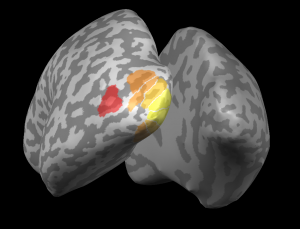Welcome
Welcome to the Visual Perception Lab of Gerrit Maus. We study how the human brain gives rise to the perception of our surroundings through our eyes.
Extrapolation and Interpolation in Visual Perception

Every day we use our sense of vision to perceive our surroundings and to interact with things in our environment. For successful interactions with things around us, it is essential to have accurate information about where things are. Oftentimes, however, our eyes cannot give us accurate information about where objects around us are located.
For example, when the objects we want to interact with are moving (e.g. when we try to hit a tennis ball), delays in the pathway from the eyes to the brain mean that our brains receive slightly outdated position information. In other situations, there are large gaps in the information from the eyes, which can be spatial gaps (e.g. when objects fall into the blind spot on the retina) or temporal gaps (e.g. when we blink).
Video: Blink of an eye (super-slow motion)

Despite these limitations in the sensory input, we excel at interacting with the world around us like no artificial system. We are able to hit fast moving tennis balls despite the delays in our nervous system. We don’t see holes in the world where our blind spots are, and we don’t see the world disappear and reappear with every eye blink. This means that the brain must have evolved sophisticated mechanisms to deal with delays and discontinuities in its sensory input. It is extrapolating and interpolating from the limited available information to build a prediction and a unified conscious percept of the world around us.

To figure out how these mechanisms work, I study a number of fascinating perceptual illusions and phenomena. In my research, I use behavioral experiments (psychophysics) in healthy participants and patients with brain damage, eye tracking, brain imaging (fMRI), and transcranial magnetic stimulation (TMS) to try to unravel the mysteries of extrapolation and interpolation in visual perception.
